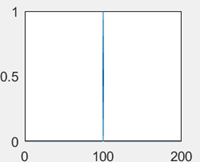Question

a.
del(t)
b.
del(t-100)
c.
del(t+100)
d.
del(t-50)
Posted under MATLAB
Engage with the Community - Add Your Comment
Confused About the Answer? Ask for Details Here.
Know the Explanation? Add it Here.
Q. What is the following graph, if del(t) represents the impulse function?
Similar Questions
Discover Related MCQs
Q. What is the Scope value if the signal generator has a frequency of 2 Hz only?
View solution
Q. What will be seen in the scope if the step time is 1 second in the following Simulink Model?
View solution
Q. What will be seen in the scope if the step time is 0 seconds in the following Simulink Model?
View solution
Q. What will be seen in the Scope if the step time is 0 seconds in the following Simulink Model and the limit of x axis is n=10?
View solution
Q. How much does the delay change, if the step time is taken as two units in time, in r(t-m), in scope 1 and 3?
View solution
Q. This is the output of scope1. What is the transfer function1?
View solution
Q. The Discrete Transfer Fcn1 is using a ramp function.
View solution
Q. What will be seen in the scope?
View solution
Q. The convolution of [1 2 1] and [1 2 1] will have the highest amplitude at t= _________
View solution
Q. Discrete time convolution is not possible in MATLAB.
View solution
Q. plot([0:1:8],[rectpulse(1,9)]’) and plot([0:1:8],ones(1,9)) will generate the same graph.
View solution
Q. If x(t-5)=0 for t<5 = A for t>=5, the signal is ___________
View solution
Q. The unit step response of an L.T.I. system is the convolution of a step signal and it’s ________
View solution
Q. What is the working of the conv2() command?
View solution
Q. The output of p=conv([ones(1,50)],[ones(1,100)]) and p=conv([ones(1,100)],[ones(1,50)]) are same.
View solution
Q. The signal get shifted by 1 units in time due to the following code: conv([ 1 2 3],[ 0 1 0 ]).
View solution
Q. For a causal L.T.I. system, the impulse response is 0 for _________
View solution
Q. The convolution of a discrete signal with itself is _________
View solution
Q. The convolution of a function with an impulse function delayed to an instant 3 in time results in ____________
View solution
Q. A continuous signal can be represented as the product of an impulse function and the signal itself.
View solution
Suggested Topics
Are you eager to expand your knowledge beyond MATLAB? We've curated a selection of related categories that you might find intriguing.
Click on the categories below to discover a wealth of MCQs and enrich your understanding of Computer Science. Happy exploring!








